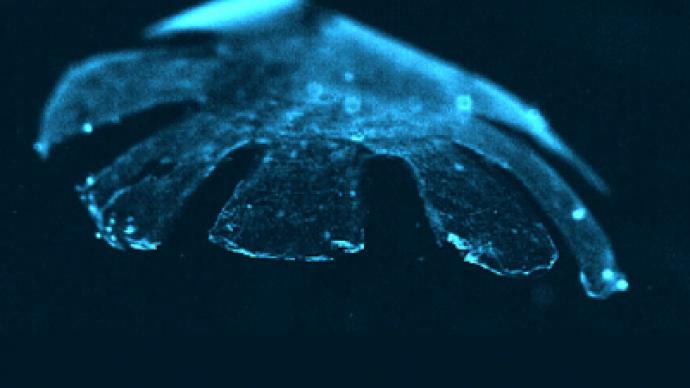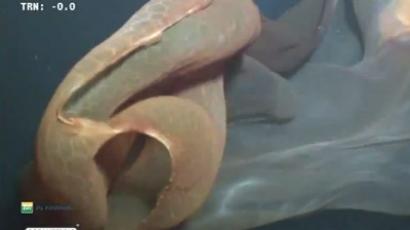JellyRat: Scientists construct artificial jellyfish from rodent cells

Scientists have reverse-engineered an artificial jellyfish using silicone and muscle cells from a rat’s heart. The replica is a spitting image of its living counterpart, and is able to pulse and swim when placed in an electric field.
The artificial creature, dubbed a medusoid, was created in order to understand the “fundamental laws of muscular pumps,” the project’s description in Nature Biotechnology magazine states. The medusoid is composed of a single layer of rat heart muscle on a patterned layer of polydimethylsiloxane, an elastic polymer that includes silicone, oxygen and hydrogen. Its movements are surprisingly similar to those of a real jellyfish. Its muscles contract when an electric current passes through it, compressing the entire structure, and mimicking the jellyfish’s power stroke. The creature then rebounds to its original shape thanks to the elastic polymer, thereby propelling itself forward.“We thought if we’re really good at this, we’re going to recreate that vortex, and we did,” noted project leader Kit Parker, a biophysicist at Cambridge University. “We took a rat apart and rebuilt it as a jellyfish. We built an animal. It’s not just about genes, but about morphology and function.”Parker’s lab specializes in creating synthetic models of human heart tissues for regenerating organs and testing drugs. Researchers have already filed a patent to use their design as a platform to test drugs. “You’ve got a heart drug?” Parker said. “You let me put it on my jellyfish, and I’ll tell you if it can improve the pumping.”The lab team is now planning to reverse-engineer a similar creature out of human heart cells. They also hope to build other maritime beings in the future.“We’ve got a whole tank of stuff in there, and an octopus on order.” Parker said. The idea to reverse-engineer a jellyfish was born in 2007, when Parker, who was studying muscular pumps, visited the New England Aquarium in Boston. He took note of the similarities between a heartbeat and the way a jellyfish pumped its way through water.Janna Nawroth, a graduate student at the California Institute of Technology, started out by mapping every cell in the body of a juvenile moon jellyfish. Its bell is made up of a single layer of muscle, along with fibers that are tightly aligned around a central ring, as well as eight spokes. The jellyfish’s bell springs into motion as electric signals spread through the muscle in a smooth wave.














